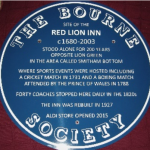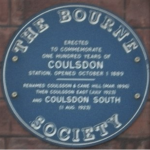The Bourne Society
The Bourne Society is a local history society covering the southern part of the London Borough of Croydon and North East Surrey. It was formed in 1956 and takes its name from the intermittent streams that follow the lines of the A22 and A23 roads in East Surrey, meeting at Purley to flow northward into the River Wandle. The Society celebrated its Golden Jubilee in 2006.
The aims of the Society are to extend knowledge of local history and to ensure the preservation of records and other objects of historical interest.
Coulsdon Review articles
Ancient Coulsdon Burial sites:
- Coulsdon Woods Roman Cemetery by David Reidy (PDF)
- Saxon Graves on Lion Green Road (2022)
- Saxon Graves on Farthing Downs
CŪTHRǢD : COULSDON’S NOBLE NAMESAKE?
Deeds Not Words: Emmeline Pankhurst in Coulsdon 1911 by Eric Jenkinson (PDF)
Coulsdon Post Boxes (PDF)
John Logie Baird’s Coulsdon Television heritage up for sale (PDF)
Bare-knuckle Fighting on Lion Green in Georgian England (PDF)
Coulsdon art trail
Coulson Art trail celebrates the history of Coulsdon with a series of finials on top of the existing finger posts in the town centre. There are now eight finials placed on top of the finger posts in the town centre.
Coulsdon Art Trail (PDF)
Coulsdon Art Trail – Gordon Pirie (PDF), the story behind the finial.
Coulsdon Art Trail – James Cooper (PDF), the story behind the finial.
Coulsdon Blue Plaques
Coulsdon Blue Plaque map (PDF)
The Bourne Society has put nine of their blue plaques on historic sites or sites of interest in and around Coulsdon and Old Coulsdon. This is a suggested walk starting in Old Coulsdon and ending at Coulsdon South station via Coulsdon Town centre which will enable you to see all of them.
Plaque no.1 is at Coulsdon Church of England School Jubilee Way. It commemorates the first local school in Coulsdon.
Plaque no.2 is on Coulsdon Manor Hotel and commemorates the Manor house of the Byron Families. After leaving plaque number 2 you can walk down Byron Avenue, named after the family, then through Hillars Heath and over the recently decorated footbridge, showing other parts of Coulsdon’s history.
Plaque no.3 is on the flats in Station Approach Road and commemorates the site of the Old Coulsdon North Station and the train crash of 1912
Plaque no.4 is on Coulsdon Town Station and commemorates the change of name from Smitham to Coulsdon Town some 100 years after the town changed its name from Smitham Bottom to Coulsdon
Plaque no.5 is on the side of Aldi’s supermarket and commemorates the Red Lion Pub which stood on this site for over 300 years.
Plaque no.6 is on the old flint stone building which is now the site of Bright Horizon’s nursery. This commemorates the first purpose-built school in Smitham Bottom
Plaques 7 and 8 are both on the front of the Comrades club.
Plaque no.7 commemorates Gordon Pirie holder of 5 world records and Olympic silver medallist in the 1956. He lived in Mead Way and was a member of the South London Harriers situated behind the Comrades club. It also commemorates Ralph Dunkley, who was a former lecturer and amateur athlete. He ran with Gordon Pirie in the team that set a 15.27.2 minute world record for the 1500m relay in 1953.
Plaque no.8 commemorates Smitham Parish Hall which was used as a school and church prior to the building of Smitham School and St Andrew’s church. Emily Pankhurst spoke there in 1911 in support of votes for women.
Plaque no.9 is at Coulsdon South Station and commemorates the opening of Coulsdon station on Brighton Line in 1889, then renamed Coulsdon & Cane Hill station in 1896.
The Bourne Society has a number of other Blue Plaques in the area. Read more about them or find out where they are.









